CTP Episode of the Day - 12.14.06 - Drive
Today's Cherished Episode: Drive (6x02)
Original Air Date: November 15, 1998
Written By: Vince Gilligan
Directed By: Rob Bowman
A carjacking and subsequent highway chase have an inexplicably deadly ending: an innocent victim's head explodes. Disobeying FBI orders, Mulder investigates -- and becomes a high-speed hostage himself.
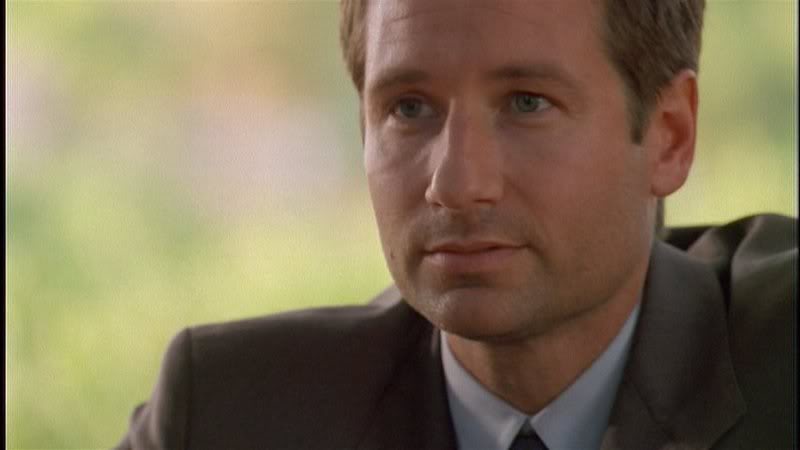
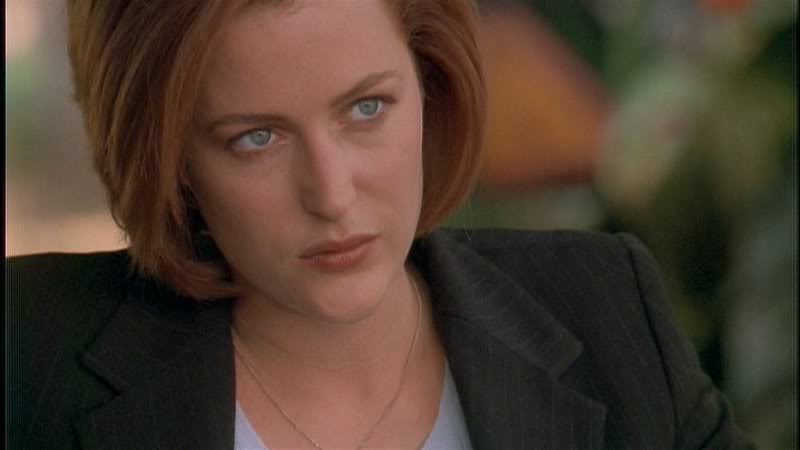


"We'll figure this out."
"You'd better figure quick. We're running out of west."
Some "Drive" Tidbits & Musings:
-- Was "Drive" the X-Files on Speed? Yes and no. Co-executive producer Vince Gilligan, sole writer on the episode, cheerfully admitted that "Drive" was partly an "homage" to the 1994 hit action movie. But Gilligan, author of some of The X-Files's most poplar and idiosyncratic installments, added that there was an additional -- and typical for the series, comically convoluted -- explanation of the existence of "Drive."
-- "I'd had this idea for a teaser for two seasons," said Gilligan. "There was this carnival, see? And it was in full swing and kids were with their parents and everyone was eating cotton candy and having a good time. And through this idyllic scene you saw a bunch of SWAT cops, running and carrying submachine guns and giving each other hand signals. And you said to yourself: 'What the hell's going on?' Then you cut to this Tilt-a-Whirl that was going full speed. There's a guy on this amusement park ride who was holding a big .44 magnum on a hostage, and he was yelling to the operator: 'If you shut this off I'll kill her.'"
-- "The Tilt-a-Whirl kept whirling," Gilligan continued. "So the SWAT cops took action -- first yelling at him through a bullhorn; then popping a tear gas canister under the Tilt-a-Whirl -- with the centrifugal force the tears came out of his eyes sideways -- then watching the bad guy's gun clatter to the pavement; then turning off the ride and taking the guy prisoner. What happened next? I had absolutely no idea. So every time I'd mention the Tilt-a-Whirl -- and it became a running joke in our story meetings -- the other guys would say, 'Where's the rest of the story? Where's the X-File here?' So I finally started joking about it. I said, 'His head explodes! That's why he doesn't want to get off the ride!' I didn't mean it seriously, not at all. But at the beginning of the season John Shiban and I were talking about it. We were looking for a story for me to write, and he said, 'Why don't you do something with that crazy Tilt-a-Whirl idea?' And I began to think about it a little more seriously. Why would someone's head explode? And the answer, surprisingly, came fairly quickly."
-- As a long-time connoisseur of dangerous-sounding government experiments, Gilligan was well aware of the controversies surrounding the military's use of extremely low frequency radio waves for secret communication. With an upfront thank you to Speed -- Mulder commenting, in the thick of the action, that "I think I saw this movie" -- he neatly reversed its main plot device, making a moving vehicle's inhabitant, not the vehicle itself, a speed-sensitive explosive.
-- Of all the episodes he has written, Gilligan said "Drive" was "the toughest," and comparatively took a long time to write. But by mid-summer he had produced a fast-paced thriller; and, to the admiration of many, a tense psychological drama as well.
-- "To me," said Rob Bowman, the episode's director, "the high point was the relationship between Mulder and Crump, the man holding him hostage. Their character arcs and attitudes to each other constantly twist and turn, the feelings they evoke in each other going from panic to anger to respect. I think Vince did a great job making the whole thing come full circle."
-- Gillian Anderson, an unabashed admirer of "Drive," agreed. "It was a great script. A great premise. I thought they carried it off really well, especially the actor who played Crump, the guy in the back seat. He was just phenomenal."
-- In point of fact, the casting of Bryan Cranston as Patrick Crump nearly didn't occur. "We'd almost decided to go with another guy. I'd called Bryan in for another part entirely," said casting director Rick Millikan. Millikan added that he remembered Cranston -- a well-regarded young actor best remembered at that time for his recurring role as the re-gifting dentist Dr. Tim Whatley on Seinfeld and as the one-armed War Department colonel in Saving Private Ryan -- as a handsome, clean-cut type not suited to play a rough, desperate character like Crump.
-- "But when Bryan came in for the other part, he had a beard and a mustache and really scraggly clothes," said Millikan. "Whether through miscommunication or something else, he came to the room prepared to read the part of Crump. I almost decided to stop him, but since he looked so perfect I let him go ahead. And then he sat down, started reading, and hit a major home run. I thought, 'My God. I've got to choose him!' A great story. A great experience."
-- "Drive" became a series of daunting challenges for a crew working together for only their second episode. The most impressive technical accomplishment of the shoot was the naturalistic lighting and filming of Mulder and Crump as their car sped along the very roads where the action took place. Amazingly, no external lights were beamed into the car's interiors.
-- The centerpiece of this effort -- rarely, if ever, tried before on a weekly television series -- was an ingenious assemblage of pipe-mounted sheets of black cardboard (constructed by key grip Tom Doherty's crew), attached to the body of the car and designed to subtract excessive sunlight from the shot. It was a brilliant feat of cinematic improvisation -- nearly invisible to viewers, as is usually the case in behind-the-scenes miracles -- a fact that was duly noted by the American Society of Cinematographers. That organization named "Drive" the best-filmed hour of episodic television of the season. Director of photography Bill Roe received the award.
-- The episode's difficult air-to-ground scenes -- as well as many of the other automotive action sequences -- were shot in a rural area around Canyon Country, in the Santa Clarita Valley, twenty miles northeast of Los Angeles. (Steven Spielberg fans might recognize it as the site of his 1971 TV movie Duel.)
-- The first attempt at aerial filming was aborted when the rented camera helicopter began spewing oil and had to make an immediate precautionary landing. Virtuosic rescheduling -- of a replacement chopper; the X-Files' second-unit film crew; and dozens of ground vehicles and other personnel -- ensued. The vital footage was obtained without incident several days later.
-- Automobiles figured prominently in "Drive's" plotline. Picture car coordinator Danny Briggs "cast" a couple of vintage Plymouth Barracuda's as Crump's getaway car and a pair of V-8 powered 1968 Chevrolet Chevelle station wagons -- which, during filming, actually went as fast as was indicated in the episode -- as the vehicle that Mulder swiped at the gas station during his frantic trip westward. One of the station wagons had its rear seats removed to fit a camera mount. One of the Barracudas had tiny remote-controlled explosive charges attached to its tires to produce on-cue blowouts during filming of the "nail strip" sequence. "It took quite a few takes to get that just right," said mechanic Kelly Padovic. "Luckily, we'd bought about 32 identical tires and rims ahead of time."
-- A scene that was explosive for other reasons -- the one in which Scully discovered dozens of dead birds on the grounds of the Crumps' trailer park -- was facilitated by props master Tom Day and his helpers renting dozens of stuffed birds from a taxidermist; painting "exploded ear canals" on several for close-up shots; and pasting feathers on toy birds to use as barely seen victims on the perimeter of the shot.
-- The shot where Crump threw a cell phone out of the moving car was accomplished by ... throwing a cell phone out of a moving car. (Although, reported second-unit production manager Harry Bring, it might have been nice if they had remembered to use the rubber dummy cell phone brought for that purpose rather than mistakenly destroy one of their only links to the production office.)
-- "Drive" marked the first substantial appearance of James Pickens, Jr., as the enigmatically hard-ass A.D. Kersh. Pickens prepared for his role by observing several of his real-life counterparts at the FBI's Los Angeles office. "The most useful thing I learned was that most of the people at Kersh's level have been with the Bureau for twenty or twenty-five years," noted the actor. "They didn't get where they are by taking their work less than seriously or bucking the system for no good reason." Pickens has, of course, moved on to another very successful series; he plays Dr. Richard Webber on Grey's Anatomy.
-- In most episodes he writes or co-writes, co-executive producer/writer Vince Gilligan salutes his girlfriend Holly Rice. In "Drive," the gas station where Mulder hijacked the station wagon was named "Holly's."
-- The scenes in this episode set in the Elko, Nevada, jail were actually filmed in the empty downtown headquarters building of the long-defunct Los Angeles Herald-Examiner. The X-Files crew returned much later in the season; parts of the derelict newsroom stood in for a Mississippi prison superintendent's office in "Trevor."
-- To give Patrick Crump the necessary look of desperation and ill health, makeup department head Cheri Montesanto-Medcalf blew menthol into actor Ryan Cranston's eyes and used liberal amounts of red eyeliner.
-- The episode title is fairly self-explanatory, but when I think of it, I always think of Bryan Cranston's great delivery of that one-word line: "Drive."
-- The date stamp for "Drive" (seen in Crump's mug shot) starts the events of the episode on the day that it aired -- November 15, 1998.
-- They had me bigtime: It may not have been the teaser that Vince Gilligan had in his head for two years, but it was pretty darn good -- and they had me bigtime. The first time I saw "Drive," when that "Special News Report" screen came up, I distinctly remember jumping up and saying "What the heck is this!?!" (Okay, I didn't say "heck." I said another four letter word that didn't start with "h" if you get my drift.) An outstanding start to the episode.
-- The Farmer asks Mulder and Scully if they are Jehovah's Witnesses, to which Mulder responded that he had a copy of the "Watchtower" for him. The "Watchtower" is a semi-monthly journal of Jehovah's Witnesses, which is usually placed along with "Awake" -- another religious magazine.
-- Scully Should Know Better: If nothing else, she should have learned in Season 2's "F. Emasculata" that one should not go poking around a body that might explode without eye or ear protection, especially when the cause of death is unknown.
-- Scully's new cell phone number was revealed to be 202-555-0166.
-- Oopsie! When we first get a shot of the odometer in Mulder's rental car, the counter is at about 2092. Then he drives and drives and drives, and when the car finally ran out of gas, the odometer was at 2043.
-- They probably thought they'd never need those Big Ass Flashlights out there in Los Angeles -- but there they are! Woo hoo!!
-- The scene where Mulder and Crump's desperate drive comes to an end was filmed at White Point Beach, a seldom-filmed Pacific overlook just south of the Los Angeles harbor community of San Pedro.
-- I'm still not exactly sure what Mulder was supposed to be doing as he fiddled with his tie and stood looking at the ocean. I defy anyone who hasn't gone to the bathroom in 24 hours to stand next to the ocean and not practically explode (and I don't mean in a Crump-like way).
-- "Big piles of manure." < g >
-- "Project Seafarer," the fictional U.S. Navy experimental communications system that exploded the Crumps' brains, had at least two (non-lethal, as far as is known) real life counterparts. Project HAARP -- for "High Frequency Active Auroral Research Program" -- is a U.S. Army system for bouncing very high intensity beams of electromagnetic radiation off the Earth's ionosphere. Project ELF -- for Extremely Low Frequency -- is a U.S. Navy project for communicating with submerged Trident submarines by radiating extremely long waves of electromagnetic energy through the Earth.
-- Researcher Lee Smith contacted the military and several military contractors to get what unclassified facts about these projects were available. "It was a funny thing," said Smith, "but when I talked to everybody the first time and asked them if the waves put out by the transmitters could harm anyone, they all told me that it was impossible. Then, totally out of the blue, a couple of them called me a few weeks later. They both said something like, 'Look, I couldn't tell you this the first time, but the answer is yes.'"
-- Though Project Seafarer did exist, it did not exist in Nevada. The two antennas were located at Clam Lake, Wisconsin, and Gwinn, Michigan. Seafarer was the subject of many protests about the environmental impact of ELF waves. In 1984, a federal judge halted construction and operation of both sites pending further environmental testing, but this ruling was overturned by an appeals court. The U.S. Navy spent $25 million studying the environmental impact and came to the conclusion that any effects were similar to those produced by power distribution cables. Needless to say, many people refused to accept these findings, claiming a government and military cover-up and leaving the whole subject perfect for use as an X-Files story. During the late 1990's, Project Seafarer was increasingly seen to be obsolete as improvements in communications technology rendered the use of ELF waves unnecessary; and Seafarer was discontinued and dismantled in September 2004.
-- Seafarer was preceded in 1968 by Project Sanguine, which proposed to use buried transmission lines spread over 22,500 square miles. Sanguine was nearly abandoned in the 1970s, but was revived as Seafarer by the Reagan administration.
-- Anyone who saw "Drive" would have had a hard time believing the actor who played Patrick Crump was the same actor who two years later would find fame as goofy dad Hal, head of the dysfunctional family on the hit Fox sitcom Malcolm in the Middle. The show lasted seven seasons and garnered three Emmy and one Golden Globe nominations for Cranston as Best Supporting Actor in a Comedy Series. Cranston also took up directing while on the show and helmed six episodes. IMBO, Bryan Cranston, like David Duchovny, is an extremely underrated actor.
-- Bryan Cranston became an ordained minister when he was in college as a part-time job. He got his acting start at the Granada Theatre in the San Fernando Valley, California. From there, he had small parts in prime-time television and also worked in soap operas and film. He met his wife Robin Dearden in 1984 while working on an episode of Airwolf. He played the villain of the week and she played his hostage. He did various work as part of the crew (voiceovers, etc.) of the Mighty Morphin' Power Rangers and the last name of the first Blue Ranger was named after him (Billy Cranston). In 2000 he produced and hosted a highly regarded kid's safety video called "KidSmartz" (the Malcolm and the Middle crew worked with him on the video during one of their week's off). During their time in the car on "Drive," Cranston and Duchovny could have talked baseball; Cranston is such a huge baseball fan that his wife threw him a surprise 40th birthday party at Dodger Stadium.
-- Cranston appeared in this summer's indie hit Little Miss Sunshine and he recently signed on for a recurring role on the CBS sitcom How I Met Your Mother.
-- Junior Brown, who played the small role of the farmer Virgil Nokes in "Drive," was in real life not an actor but an avante garde country music singer/songwriter/steel guitar player (his best known song: "My Wife Thinks You're Dead") with a cult following. One of his biggest fans is Vince Gilligan, who thought he would be so right for the part -- and so much wanted to meet him -- that he put up his own money to fly him in from Oklahoma. "I made sure to visit the set that day to get his autograph," said Gilligan. "He's a great guy!" Brown recently had another acting gig, though he didn't appear on screen -- he was the balladeer in The Dukes of Hazzard, taking over for Waylon Jennings who did the honors on the TV series. Brown's song, "My Wife Thinks You're Dead" was also used on the Dukes soundtrack.
-- Harry Danner, who played the CDC doctor, is the brother of actress Blythe Danner, who played Jana Cassidy in the X-Files movie.
-- Michael O'Neill (The Patrol Captain) went on to a recurring role on The West Wing as Secret Service Agent Ron Butterfield, and recently appeared in episodes of The Nine and 3 Lbs.. Mindy Seeger (The Coroner) also had a recurring role in The West Wing as Chris.
-- Art Pickering (Germ Suit Cop) would join the show in Season 8 as an assistant to the writing staff. His name appears in Scully's computer data base in "Per Manum."
-- Once & Future Retreads: Scott Alan Smith (Prison Doctor) was a Technician in The X-Files Movie: Fight the Future.
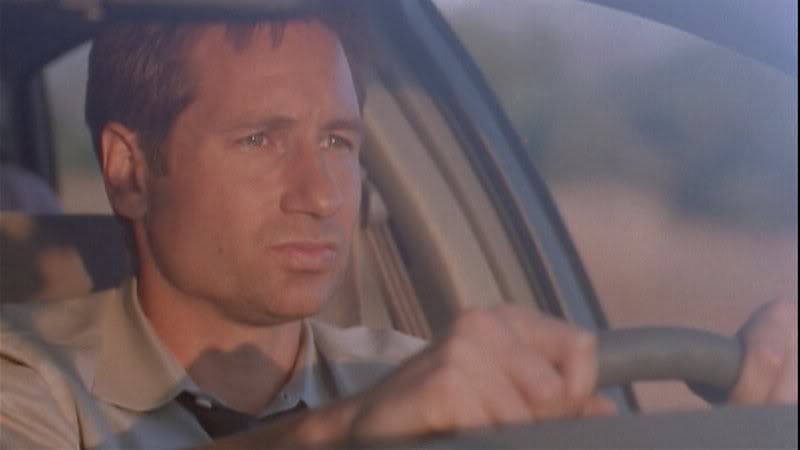
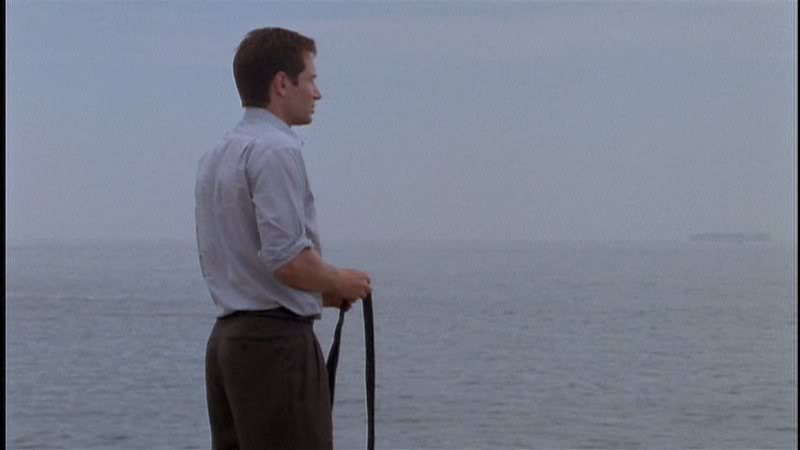

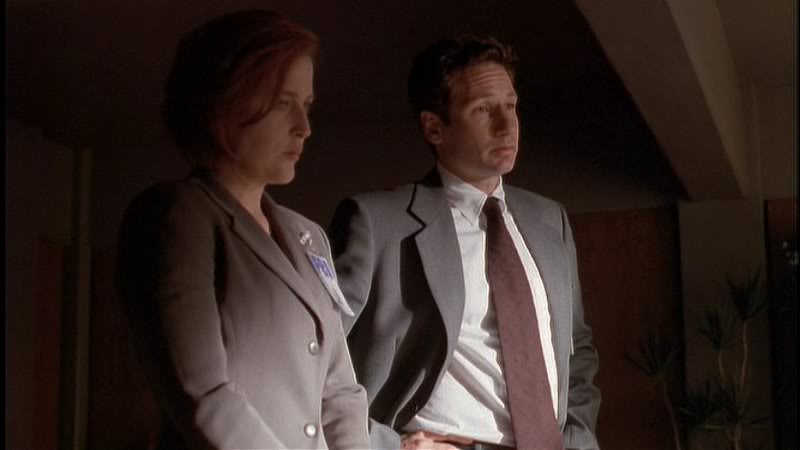
(Thanks to chrisnu for today's pics.)
Please share your first impressions, favorite (or cringe-worthy) moments, classic lines, favorite fanfic, nagging questions, repeated viewing observations, etc., as today we celebrate "Drive."
Polly